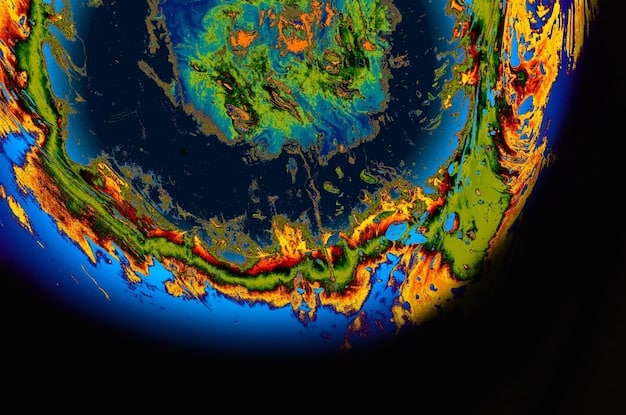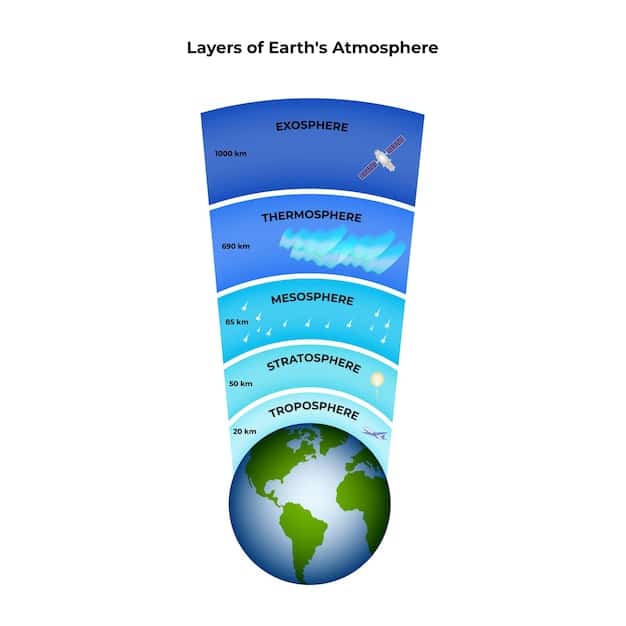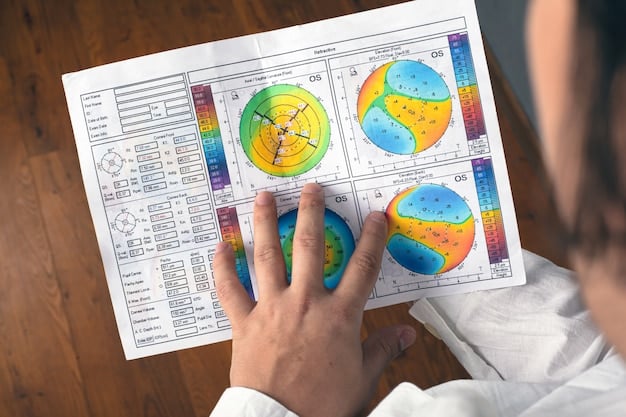Climate Modeling: Accuracy, Projections and What We Learn

Exploring the science of climate modeling reveals that while these models are not perfect, they are crucial tools for understanding potential future climate scenarios, aiding in policy decisions and adaptation strategies by projecting long-term trends and informing about the range of possibilities, hence improving preparedness for the impact of climate change.
Exploring the science of climate modeling is essential for understanding and predicting the complex dynamics of our planet’s climate. These models, sophisticated computer programs that simulate the Earth’s climatic processes, play a pivotal role in projecting future climate scenarios and informing policy decisions.
Understanding Climate Models: The Basics
Climate models are sophisticated tools that scientists use to simulate the Earth’s climate system. These models include various factors such as atmospheric conditions, ocean currents, land surface processes, and the effects of greenhouse gases.
By integrating these components, climate models help researchers understand past climate conditions and predict future climate scenarios.
Key Components of Climate Models
Climate models are not just about temperature; they incorporate a wide range of interacting systems. These include:
- Atmosphere: Simulates air temperature, humidity, wind, and precipitation.
- Ocean: Models ocean currents, water temperature, and salinity.
- Land Surface: Considers vegetation cover, soil moisture, and snow and ice cover.
- Cryosphere: Focuses on ice sheets, glaciers, and sea ice.
- Biogeochemistry: Includes carbon cycle and other chemical processes.
The complexity of these models is crucial for accurately representing the interconnectedness of the Earth’s climate system.
Climate models solve mathematical equations that describe the physical laws governing the interactions between these systems. High-performance computers are essential for running these complex simulations.

In essence, climate models are invaluable tools for understanding the complex and interdependent systems that influence our climate.
How Climate Models Work: A Deeper Dive
Climate models work by dividing the Earth’s surface and atmosphere into a three-dimensional grid. Each grid cell is then used to calculate various parameters, such as temperature, pressure, and humidity, using mathematical equations that represent physical laws.
These calculations are performed repeatedly over time to simulate how the climate evolves.
The Role of Equations and Data
At their core, climate models rely on fundamental physical laws and equations, including:
- Conservation of Energy: Ensuring that energy is neither created nor destroyed within the system.
- Newton’s Laws of Motion: Describing how air and water move around the planet.
- Thermodynamics: Explaining how heat is transferred and transformed.
Besides equations, data from observations play a crucial role in initializing and validating climate models.
Climate models integrate different data types, including satellite observations, weather station measurements, ocean buoy readings, and historical climate records.
By incorporating real-world data, climate models can be calibrated and refined, leading to more accurate projections.
In this manner, equations and data converge to drive climate models, enhancing their ability to predict future climate scenarios.
Evaluating the Accuracy of Climate Projections
Assessing the accuracy of climate projections involves comparing model simulations with historical climate data. Scientists evaluate how well models replicate past climate conditions and trends.
This evaluation helps to identify strengths and weaknesses in the models, guiding improvements and refinements.
Benchmarking Against Historical Data
One of the primary methods for evaluating model accuracy is to compare climate projections with observed climate data from the past.
- Temperature Records: Comparing model-simulated temperature trends with historical temperature records.
- Precipitation Patterns: Assessing the accuracy of models in replicating observed precipitation patterns.
- Extreme Weather Events: Evaluating how well models simulate the frequency and intensity of extreme weather events.
These historical benchmarks provide essential insights into model performance and reliability.
Dealing with Uncertainty
Climate projections are inherently uncertain due to the complexity of the climate system and the range of potential future scenarios. Uncertainty arises from various sources, including:
- Model Limitations: Imperfect representations of physical processes.
- Scenario Uncertainty: Varying assumptions about future greenhouse gas emissions and other factors.
- Natural Variability: Inherent fluctuations in the climate system.
Climate scientists use various techniques to quantify and communicate uncertainty in climate projections, such as providing ranges of possible outcomes and identifying the sources of uncertainty.

Through rigorous evaluation and careful consideration of uncertainty, scientists strive to provide the most accurate and reliable climate projections possible.
The Role of Climate Models in Policy and Planning
Climate models play a crucial role in shaping climate policies and adaptation strategies. Projections from climate models inform policymakers and stakeholders about the potential impacts of climate change.
That results in empowering them to make informed decisions to mitigate and adapt to these effects.
Informing Policy Decisions
Climate models provide essential information for policymakers who are developing strategies to reduce greenhouse gas emissions and mitigate climate change.
- Emissions Targets: Setting targets for reducing greenhouse gas emissions based on climate model projections.
- Policy Evaluation: Evaluating the effectiveness of different climate policies using climate models.
- International Agreements: Informing international agreements and negotiations on climate change.
The insights gained from climate models help guide the development of effective and targeted climate policies.
Adaptation Strategies
In addition to informing mitigation efforts, climate models are crucial for developing adaptation strategies to cope with the inevitable impacts of climate change.
For instance:
- Infrastructure Planning: Designing infrastructure that can withstand the impacts of climate change, such as sea-level rise and extreme weather events.
- Resource Management: Managing water and agricultural resources to adapt to changing climate conditions.
- Public Health: Preparing for the health impacts of climate change, such as heat waves and vector-borne diseases.
By providing detailed regional climate projections, climate models help communities and organizations prepare for and adapt to the challenges of a changing climate.
Limitations and Challenges in Climate Modeling
Despite their sophistication, climate models are not perfect. They have several limitations and challenges that scientists are constantly working to address.
These include accurately representing complex feedback mechanisms, simulating regional climate patterns, and reducing uncertainty in projections.
Representing Complex Feedback Mechanisms
The climate system is full of complex feedback mechanisms that can amplify or dampen the effects of climate change. Accurately representing these feedback mechanisms in climate models is a major challenge. Examples include:
- Cloud Feedbacks: Changes in cloud cover can either amplify or dampen warming, depending on the type of cloud and its location. Predicting cloud feedbacks accurately is one of the greatest sources of uncertainty in climate models.
- Ice-Albedo Feedback: As ice and snow melt, they expose darker surfaces that absorb more sunlight, leading to further warming. This feedback loop can accelerate the rate of climate change.
- Carbon Cycle Feedbacks: Changes in temperature and precipitation can affect the ability of ecosystems to absorb carbon dioxide, leading to changes in atmospheric carbon dioxide concentrations.
Improving the representation of these feedback mechanisms is critical for enhancing the accuracy of climate models.
Simulating Regional Climate Patterns
While global climate models can provide valuable insights into overall climate trends, they often struggle to accurately simulate regional climate patterns. Due to their coarse resolution, global models may not capture small-scale processes that are important at the regional level. Techniques for addressing include:
- Downscaling: Process that takes output from global climate models and uses statistical or dynamical methods to generate higher-resolution regional climate projections.
- Regional Climate Models: Higher-resolution models that focus on specific regions of the world.
By using downscaling techniques and regional climate models, scientists can improve the accuracy of climate projections at the regional level, providing more useful information for local decision-making.
Future Directions in Climate Modeling
The field of climate modeling is continually evolving, with ongoing research focused on improving model accuracy, reducing uncertainty, and expanding the scope of climate projections. Future directions in climate modeling include:
Advancements in computing power, improved data assimilation techniques, and integration of new observations are driving progress in the field.
Advancements in Computing Power
Climate models are computationally intensive, requiring vast amounts of computing power to run complex simulations. As computing power continues to increase, scientists will be able to:
- Run Higher-Resolution Models: Higher-resolution models can capture smaller-scale processes and provide more detailed regional climate projections.
- Incorporate More Complex Processes: More complex models can include additional factors, such as atmospheric chemistry and land use change, leading to more comprehensive climate simulations.
- Run More Simulations: Running multiple simulations with different initial conditions and parameters can help to quantify uncertainty and provide more robust climate projections.
The supercomputing capabilities are essential for advancing the state of climate modeling.
Improved Data Assimilation Techniques
Data assimilation is the process of integrating observational data into climate models. By improving data assimilation techniques, scientists can:
- Reduce Uncertainty: Integrating more observational data into climate models can help to reduce uncertainty in climate projections.
- Improve Model Calibration: Data assimilation can help to calibrate climate models and improve their ability to replicate observed climate conditions.
- Enhance Model Initialization: Data assimilation can provide better initial conditions for climate models, leading to more accurate short-term climate predictions.
These advancements will continue to improve the reliability and accuracy of climate projections, providing policymakers and stakeholders with the information they need to address the challenges of climate change.
| Key Point | Brief Description |
|---|---|
| 🌏 Climate Models | Simulate Earth’s climate system to understand past and future conditions. |
| 📊 Accuracy Evaluation | Benchmarked against historical data to identify strengths and weaknesses. |
| 🎯 Policy & Planning | Inform policy decisions and adaptation strategies for climate change. |
| 💻 Future Directions | Advancements in computing, data, and techniques for better projections. |
Frequently Asked Questions
▼
Climate models are computer simulations of the Earth’s climate system. They use mathematical equations to represent interactions between the atmosphere, oceans, land, and ice, helping scientists understand and predict climate change.
▼
Climate projections are generally accurate in predicting long-term trends, but they have limitations. Models are evaluated against historical data, and uncertainties arise from model limitations and future emission scenarios, but are improving all the time.
▼
Climate models include various factors such as atmospheric conditions, ocean currents, land surface processes, and the effects of greenhouse gases. Integrating these components is key to understanding the Earth’s climate system.
▼
Climate models provide essential information for policymakers, helping them set emissions targets, evaluate climate policies, and inform international agreements on climate change based on predicted impacts and trends.
▼
Limitations include difficulty accurately representing complex feedback mechanisms and simulating regional climate patterns due to model resolution. Scientists are continuously working to improve the underlying technology to reduce these uncertainties.
Conclusion
In conclusion, exploring the science of climate modeling reveals its critical role in understanding and projecting future climate scenarios. While challenges and uncertainties persist, ongoing advancements in computing power, data, and techniques promise to enhance the accuracy and reliability of climate projections, empowering informed decision-making for a sustainable future.





